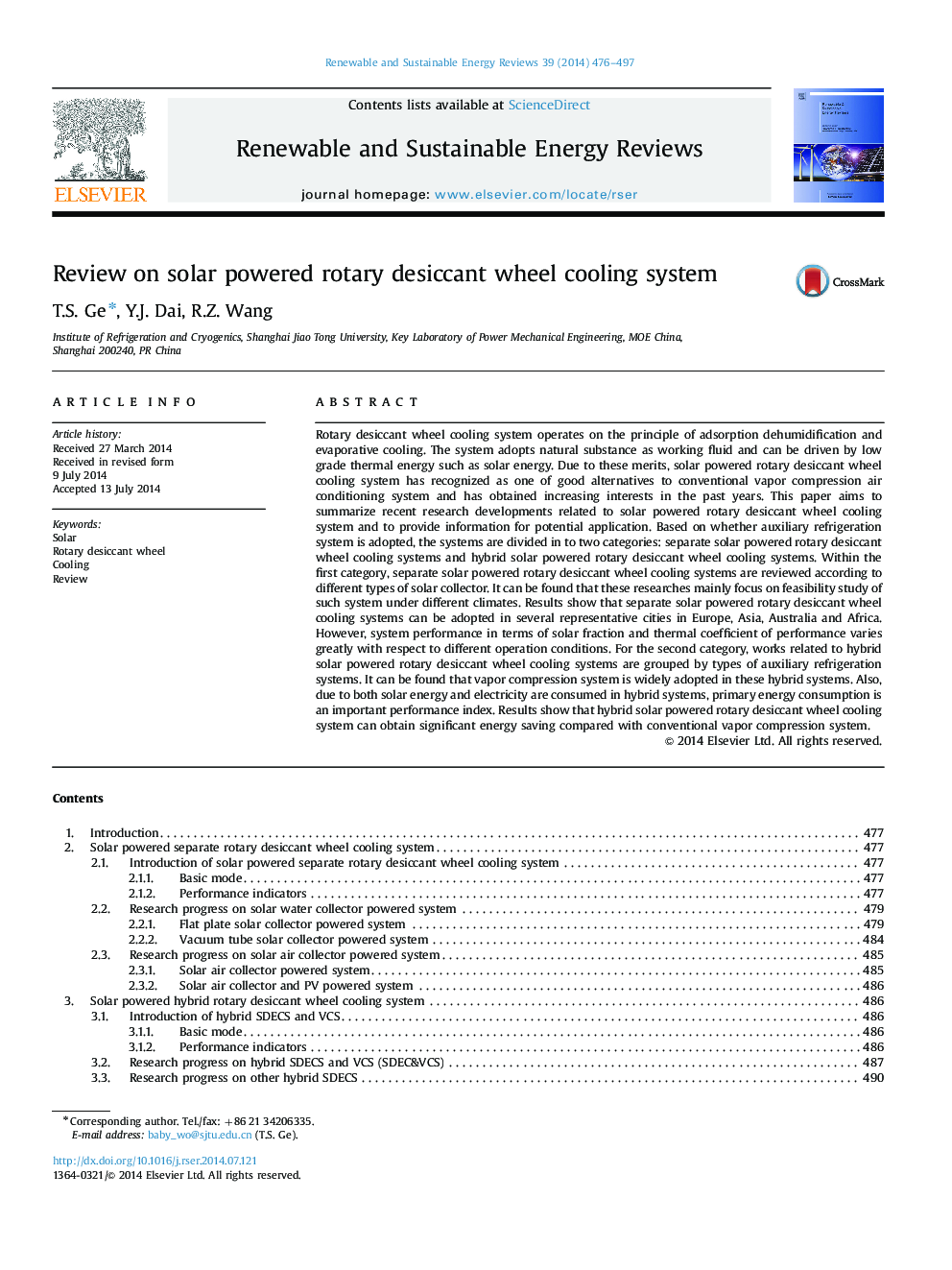| کد مقاله | کد نشریه | سال انتشار | مقاله انگلیسی | نسخه تمام متن |
|---|---|---|---|---|
| 8119004 | 1522346 | 2014 | 22 صفحه PDF | دانلود رایگان |
عنوان انگلیسی مقاله ISI
Review on solar powered rotary desiccant wheel cooling system
ترجمه فارسی عنوان
بررسی سیستم خنک کننده چرخ دیزکاتور چرخ خورشیدی
دانلود مقاله + سفارش ترجمه
دانلود مقاله ISI انگلیسی
رایگان برای ایرانیان
کلمات کلیدی
خورشیدی، چرخ دیزکاتور چرخ، خنک کننده مرور،
ترجمه چکیده
سیستم خنک کننده دوار روتاری بر اساس اصل رطوبت جذب و خنک کننده تبخیری عمل می کند. این سیستم مواد طبیعی را به عنوان مایع کار می گیرد و می تواند توسط انرژی حرارتی کم انرژی مانند انرژی خورشیدی هدایت شود. با توجه به این شایستگی ها، سیستم خنک کننده ی چرخ خنک کننده موتور دیزکاتور به عنوان یکی از جایگزین های مناسب برای سیستم تهویه مطبوع فشرده سازی معمولی شناخته شده است و در سال های گذشته افزایش منافع به دست آورده است. این مقاله با هدف خلاصه ای از تحولات تحقیقاتی اخیر مربوط به سیستم خنک کننده چرخ دیزکاتور خورشیدی و ارائه اطلاعات برای کاربرد بالقوه است. بر اساس این که آیا سیستم تبرید کمکی تصویب شده است، سیستم ها به دو دسته تقسیم می شوند: سیستم خنک کننده دو چرخ خنک کننده جدا شده خورشیدی و سیستم های خنک کننده دو چرخ خنک کننده خنک کننده. در دسته اول، سیستم های خنک کننده ی چرخ دیزل جداگانه خورشیدی با توجه به انواع مختلفی از مجموعه ی خورشیدی مورد بررسی قرار می گیرند. می توان دریافت که این تحقیق به طور عمده بر روی مطالعه امکان سنجی چنین سیستمی در هوای های مختلف تمرکز می کند. نتایج نشان می دهد که سیستم های خنک کننده دو چرخ خنک کننده خورشیدی را می توان در چندین شهر نمایندگی در اروپا، آسیا، استرالیا و آفریقا استفاده کرد. با این حال، عملکرد سیستم از لحاظ کسر خورشید و ضریب حرارت از عملکرد با توجه به شرایط عملیاتی مختلف متفاوت است. برای دسته دوم، آثار مربوط به سیستم های خنک کننده دو چرخ خنک کننده هیبرید خورشیدی با انواع سیستم های تبرید کمکی گروه بندی می شوند. می توان دریافت که سیستم فشرده سازی بخار در این سیستم های ترکیبی به طور گسترده ای مورد استفاده قرار می گیرد. همچنین، به دلیل انرژی خورشیدی و برق در سیستم های ترکیبی مصرف می شود، مصرف انرژی اولیه یک شاخص عملکرد مهم است. نتایج نشان می دهد که سیستم خنک کننده چرخ دیزل هیبریدی خورشیدی می تواند صرفه جویی در انرژی قابل توجهی را نسبت به سیستم فشرده سازی بخار معمولی به دست آورد.
موضوعات مرتبط
مهندسی و علوم پایه
مهندسی انرژی
انرژی های تجدید پذیر، توسعه پایدار و محیط زیست
چکیده انگلیسی
Rotary desiccant wheel cooling system operates on the principle of adsorption dehumidification and evaporative cooling. The system adopts natural substance as working fluid and can be driven by low grade thermal energy such as solar energy. Due to these merits, solar powered rotary desiccant wheel cooling system has recognized as one of good alternatives to conventional vapor compression air conditioning system and has obtained increasing interests in the past years. This paper aims to summarize recent research developments related to solar powered rotary desiccant wheel cooling system and to provide information for potential application. Based on whether auxiliary refrigeration system is adopted, the systems are divided in to two categories: separate solar powered rotary desiccant wheel cooling systems and hybrid solar powered rotary desiccant wheel cooling systems. Within the first category, separate solar powered rotary desiccant wheel cooling systems are reviewed according to different types of solar collector. It can be found that these researches mainly focus on feasibility study of such system under different climates. Results show that separate solar powered rotary desiccant wheel cooling systems can be adopted in several representative cities in Europe, Asia, Australia and Africa. However, system performance in terms of solar fraction and thermal coefficient of performance varies greatly with respect to different operation conditions. For the second category, works related to hybrid solar powered rotary desiccant wheel cooling systems are grouped by types of auxiliary refrigeration systems. It can be found that vapor compression system is widely adopted in these hybrid systems. Also, due to both solar energy and electricity are consumed in hybrid systems, primary energy consumption is an important performance index. Results show that hybrid solar powered rotary desiccant wheel cooling system can obtain significant energy saving compared with conventional vapor compression system.
ناشر
Database: Elsevier - ScienceDirect (ساینس دایرکت)
Journal: Renewable and Sustainable Energy Reviews - Volume 39, November 2014, Pages 476-497
Journal: Renewable and Sustainable Energy Reviews - Volume 39, November 2014, Pages 476-497
نویسندگان
T.S. Ge, Y.J. Dai, R.Z. Wang,
